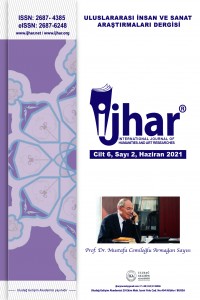Abstract
Tarihsel süreçte ilk tekstil ürünlerinden biri olarak karşımıza çıkan keçe, biçim alma yeteneği yüksek, nefes alabilen, nem tutma özelliği olan yün elyafının keçeleştirme işlemi sonucu elde edilmektedir. Geçmişten günümüze keçeyi meydana getiren yün elyafı ve geleneksel üretim tekniği, işlevsel kullanımı ile yaşantımızda önemli bir yeri olan keçe ticaretinin yapılması nedeniyle dünya tekstil sektöründe önemli bir paya sahiptir.
Keçe denildiğinde ilk akla gelen geleneksel üretim tekniği ve işlevsel kullanımı olsa da, günümüzde boyut kazanabilen yapısı ile keçe, bu özelliği sonucunda çeşitli sanatçılar tarafından sanatsal bir ifade aracı olarak da kullanılmaktadır. Aynı zamanda tekstil sektöründe, keçenin yüzey tasarım olanaklarını kullanarak ürün tasarımı uygulamaları yapan tasarımcılar da bulunmaktadır.
Bu tasarımcılardan biri olan Liora Manne, alanında etkili tasarımlar yapan ve kabul gören önemli bir isimdir. Amerika Birleşik Devletleri’nde lisansüstü tekstil tasarımı ve tekstil mühendisliği eğitimi gören tasarımcı, yün ve sentetik elyaf kullandığı keçe yapılar ile farklı yaşam tarzları için ürün tasarımları yapmaktadır. Manne, güçlü renk kompozisyonları ile özellikle ev tekstili alanında işlevsel ve sanatsal özgün tasarımlar gerçekleştirmektedir. Bu makalede ele alınmasının nedeni, geleneksel yöntemlerle yüzyıllardır uygulanan keçeleştirme eylemini, Manne’nin kendi üslubunda oluşturduğu özgün bir yöntemle kullanarak farklılaştırması, tasarım ve sanatsal değerleri yüksek uygulamalarını iç mekân ve ev tekstili alanlarında sergilemesidir.
Bu çalışmada, keçe ile ilgili literatür bilgileri incelenmiş, keçenin sanatsal yönünü ele alınarak, alanında hem işlevsel hem de sanatsal özgün tasarımlar gerçekleştiren Manne ile yapılan yarı yapılandırılmış görüşme ile eserleri hakkında sistematik bilgiler elde edilmiştir. Bu bilgiler doğrultusunda tasarım ve sanat alanında yapılacak çalışmalara örnek oluşturarak literatüre katkı sağlanması amaçlanmıştır.
References
- Acar, S. (2010). Yünlü Giysi Tasarımında Bölgesel Keçeleştirme Yöntem ve Uygulamaları. Dokuz Eylül Üniversitesi Güzel Sanatlar Enstitüsü Sanatta Yeterlik Tezi, Tez Danışmanı: Doç. Nesrin Önlü. İzmir.
- Akça, Ü., Uzun Vıcıl, A. (2015). Keçe’de Yeni Anlayış. ITCC 2015 International Textiles Costume Congres, 4-6 Kasım 2015, İstanbul, s.50-53.
- Atiş Özhekim, D. (2009). Keçenin Hikâyesi ve Sanatsal Üretimler. Zeitschrift für die Welt der Türken Journal of World of Turks. Vol.1, No.1, s.124.
- Başer, İ. (1992). Elyaf Bilgisi. İstanbul: Marmara Üniversitesi Yayınları.
- Ergür, A. (2002). Tekstil Terimleri Sözlüğü. İstanbul: Boğaziçi Üniversitesi Yayınevi.
- Erzurumlu Jorayev, Ö. (2018). Sanat Nesnesi Olarak Keçe. Uluslararası Kültür, Sanat ve Toplum Sempozyumu, 18-20 Ekim 2018, Van, s. 586-599.
- Gür, S. (2012). Anadolu’nun Sanat Objesine Dönüşen Kültürel Değeri Keçe. Batman Üniversitesi Yaşam Bilimleri Dergisi. Cilt 1. Sayı 1. s. 1173-1181.
- Gürcüm, B. H. (2005). Tekstil Malzeme Bilgisi. Ankara: Grafiker Yayınları.
- Hagen, C. A. (2002). Feltmaking: Fabulous Wearables, Jewelry & Home Accents, New York: Lark Books.
- Ovacık, M., Gümüşer, T. (2016). Geçmişten Günümüze Keçe: Ayfer Güleç İş Modeli Üzerine Bir Analiz. Yedi Sanat, Tasarım ve Bilim Dergisi. Sayı 15. s. 155-171.
- Topbaş, A., Seyirci, M. (1982). Keçecilik ve Batı Anadolu’daki Bazı Keçe Merkezleri. 11. Ulusal El Sanatları Sempozyumu, 18-20 Kasım 1982, s.254-268.
- http://www.lioramanne.com/become-inspired/ (20.01.2021).
- Manne, Liora. Çevrimiçi Ortamda Sözlü Görüşme kayıtları (06.01.2021).
- Manne, Liora. Çevrimiçi Ortamda Yazılı Görüşme kayıtları (13.01.2021).
Abstract
Felt, which appears to be one of the first textile products in the historical process, is obtained as a result of the felting process of wool fiber that has a high ability to form, breathes, and holds humide. Wool fiber, has an important share in the world of textile sector with its trade capacity, is used to produce felt that has an important place in our lives with its traditional production type and use from the past to present.
Although the first thing that comes to mind when it comes to felt is the traditional production and its function, with the help of its ability to have dimensions, today there are artists who use felt as expression of art. There are designers, who make product applications in the textile industry, use felt on surface design.
Liora Manne, one of these designers, is an important name that has effective designs and is well accepted in the field. Designer, who had postgraduate textile design and textile engineering education in United States of America, is designing lifestyle products with felt made out of wool and synthetic fibers. Manne creates artistic and functional designs, especially in the field of home textiles, with its colorful color compositions. The reason why she is the subject of this article is that she differenciates the traditional method used for centuries, uses her own unique style on interior and home textile applications with her design and artistic value.
The purpose of his work; To introduce Manne, who performs functional and artistic unique designs, who can set an example for researches to be made in the fields of education, design and art, and to contribute to the literature. The subject will be examined with content analysis method from qualitative methods, and tools such as books, theses, articles, internet resources will be used.
Keywords
References
- Acar, S. (2010). Yünlü Giysi Tasarımında Bölgesel Keçeleştirme Yöntem ve Uygulamaları. Dokuz Eylül Üniversitesi Güzel Sanatlar Enstitüsü Sanatta Yeterlik Tezi, Tez Danışmanı: Doç. Nesrin Önlü. İzmir.
- Akça, Ü., Uzun Vıcıl, A. (2015). Keçe’de Yeni Anlayış. ITCC 2015 International Textiles Costume Congres, 4-6 Kasım 2015, İstanbul, s.50-53.
- Atiş Özhekim, D. (2009). Keçenin Hikâyesi ve Sanatsal Üretimler. Zeitschrift für die Welt der Türken Journal of World of Turks. Vol.1, No.1, s.124.
- Başer, İ. (1992). Elyaf Bilgisi. İstanbul: Marmara Üniversitesi Yayınları.
- Ergür, A. (2002). Tekstil Terimleri Sözlüğü. İstanbul: Boğaziçi Üniversitesi Yayınevi.
- Erzurumlu Jorayev, Ö. (2018). Sanat Nesnesi Olarak Keçe. Uluslararası Kültür, Sanat ve Toplum Sempozyumu, 18-20 Ekim 2018, Van, s. 586-599.
- Gür, S. (2012). Anadolu’nun Sanat Objesine Dönüşen Kültürel Değeri Keçe. Batman Üniversitesi Yaşam Bilimleri Dergisi. Cilt 1. Sayı 1. s. 1173-1181.
- Gürcüm, B. H. (2005). Tekstil Malzeme Bilgisi. Ankara: Grafiker Yayınları.
- Hagen, C. A. (2002). Feltmaking: Fabulous Wearables, Jewelry & Home Accents, New York: Lark Books.
- Ovacık, M., Gümüşer, T. (2016). Geçmişten Günümüze Keçe: Ayfer Güleç İş Modeli Üzerine Bir Analiz. Yedi Sanat, Tasarım ve Bilim Dergisi. Sayı 15. s. 155-171.
- Topbaş, A., Seyirci, M. (1982). Keçecilik ve Batı Anadolu’daki Bazı Keçe Merkezleri. 11. Ulusal El Sanatları Sempozyumu, 18-20 Kasım 1982, s.254-268.
- http://www.lioramanne.com/become-inspired/ (20.01.2021).
- Manne, Liora. Çevrimiçi Ortamda Sözlü Görüşme kayıtları (06.01.2021).
- Manne, Liora. Çevrimiçi Ortamda Yazılı Görüşme kayıtları (13.01.2021).
Details
| Primary Language | Turkish |
|---|---|
| Journal Section | Research Articles |
| Authors | |
| Publication Date | June 30, 2021 |
| Submission Date | May 20, 2021 |
| Acceptance Date | June 1, 2021 |
| Published in Issue | Year 2021 Volume: 6 Issue: 2 |




International Journal of Human and Art Studies İJHAR; Licensed under the Creative Commons Attribution 4.0 International License.
International Journal of Human and Art Studies IJHAR has been registered with the decision of the Turkish Patent and Trademark Office, numbered 71248886-2020/24446 / E.2020-OE-458377.


